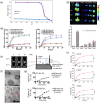A landscape of recent advances in lipid nanoparticles and their translational potential for the treatment of solid tumors
- PMID: 38435821
- PMCID: PMC10905562
- DOI: 10.1002/btm2.10601
A landscape of recent advances in lipid nanoparticles and their translational potential for the treatment of solid tumors
Abstract
Lipid nanoparticles (LNPs) are biocompatible drug delivery systems that have found numerous applications in medicine. Their versatile nature enables the encapsulation and targeting of various types of medically relevant molecular cargo, including oligonucleotides, proteins, and small molecules for the treatment of diseases, such as cancer. Cancers that form solid tumors are particularly relevant for LNP-based therapeutics due to the enhanced permeation and retention effect that allows nanoparticles to accumulate within the tumor tissue. Additionally, LNPs can be formulated for both locoregional and systemic delivery depending on the tumor type and stage. To date, LNPs have been used extensively in the clinic to reduce systemic toxicity and improve outcomes in cancer patients by encapsulating chemotherapeutic drugs. Next-generation lipid nanoparticles are currently being developed to expand their use in gene therapy and immunotherapy, as well as to enable the co-encapsulation of multiple drugs in a single system. Other developments include the design of targeted LNPs to specific cells and tissues, and triggerable release systems to control cargo delivery at the tumor site. This review paper highlights recent developments in LNP drug delivery formulations and focuses on the treatment of solid tumors, while also discussing some of their current translational limitations and potential opportunities in the field.
Keywords: chemotherapy; drug combination; gene therapy; immunotherapy; lipid nanoparticles; solid tumors; translational limitations.
© 2023 The Authors. Bioengineering & Translational Medicine published by Wiley Periodicals LLC on behalf of American Institute of Chemical Engineers.
Conflict of interest statement
The authors declare no conflict of interest.
Figures










Similar articles
-
Lipid Nanoparticle-mRNA Formulations for Therapeutic Applications.Acc Chem Res. 2021 Dec 7;54(23):4283-4293. doi: 10.1021/acs.accounts.1c00550. Epub 2021 Nov 18. Acc Chem Res. 2021. PMID: 34793124 Free PMC article.
-
Advanced Targeted Therapy for Colorectal Cancer with Lipid Nanoparticles.Curr Med Chem. 2025 Jan 16. doi: 10.2174/0109298673327576241201145252. Online ahead of print. Curr Med Chem. 2025. PMID: 39819540
-
Micro-syringe chip-guided intratumoral administration of lipid nanoparticles for targeted anticancer therapy.Biomater Res. 2023 Oct 16;27(1):102. doi: 10.1186/s40824-023-00440-4. Biomater Res. 2023. PMID: 37845762 Free PMC article.
-
Lipid Nanoparticles─From Liposomes to mRNA Vaccine Delivery, a Landscape of Research Diversity and Advancement.ACS Nano. 2021 Nov 23;15(11):16982-17015. doi: 10.1021/acsnano.1c04996. Epub 2021 Jun 28. ACS Nano. 2021. PMID: 34181394 Review.
-
Developing Biodegradable Lipid Nanoparticles for Intracellular mRNA Delivery and Genome Editing.Acc Chem Res. 2021 Nov 2;54(21):4001-4011. doi: 10.1021/acs.accounts.1c00500. Epub 2021 Oct 20. Acc Chem Res. 2021. PMID: 34668716 Review.
Cited by
-
Naringenin as potent anticancer phytocompound in breast carcinoma: from mechanistic approach to nanoformulations based therapeutics.Front Pharmacol. 2024 Jun 18;15:1406619. doi: 10.3389/fphar.2024.1406619. eCollection 2024. Front Pharmacol. 2024. PMID: 38957397 Free PMC article. Review.
-
Lipid-Based Nanocarriers: Bridging Diagnosis and Cancer Therapy.Pharmaceutics. 2024 Sep 1;16(9):1158. doi: 10.3390/pharmaceutics16091158. Pharmaceutics. 2024. PMID: 39339195 Free PMC article. Review.
-
Ferulic Acid: A Comprehensive Review.Cureus. 2024 Aug 28;16(8):e68063. doi: 10.7759/cureus.68063. eCollection 2024 Aug. Cureus. 2024. PMID: 39347187 Free PMC article. Review.
-
Exploring the therapeutic potential of lipid-based nanoparticles in the management of oral squamous cell carcinoma.Explor Target Antitumor Ther. 2024;5(6):1223-1246. doi: 10.37349/etat.2024.00272. Epub 2024 Sep 29. Explor Target Antitumor Ther. 2024. PMID: 39465011 Free PMC article. Review.
-
Regulating Immune Responses Induced by PEGylated Messenger RNA-Lipid Nanoparticle Vaccine.Vaccines (Basel). 2024 Dec 27;13(1):14. doi: 10.3390/vaccines13010014. Vaccines (Basel). 2024. PMID: 39852793 Free PMC article. Review.
References
Publication types
LinkOut - more resources
Full Text Sources

